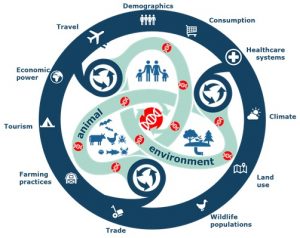15 July 2020, the VEO (Versatile Emerging infectious disease Observatory) project – a research consortium of 20 partners from 12 European countries – officially started.
Over the next 5 years, VEO will investigate whether it is possible to develop an interactive, virtual detection system that can monitor and analyse a wide range of information sources such as laboratory studies, field studies and big data.
Aim: the earlier signalling and detection of outbreaks of new infectious diseases. This is a relevant project in view of the recent SARS-CoV-2 pandemic.
VEO has received 15 million euros for the research from the Horizon2020 programme of the European Commission. The project will be coordinated by Prof. Marion Koopmans, head of the Department of Viroscience, Erasmus MC.
Due to the increasing mobility of people, climate change and the globalisation of food chains, the frequency and impact of infectious diseases outbreaks are increasing. A high proportion of these infectious diseases can be transferred from animals to humans (zoonoses). Well-known examples of this are Ebola, SARS, Lassa and, since January 2020, SARS-CoV-2.
To detect outbreaks faster, it is important that we gain a better understanding of which factors play a role in the transmission of infectious diseases from animals to humans.
Linking data sources and citizen science
The recent outbreak of SARS-CoV-2 clearly reveals what the consequences of an outbreak can be if it is discovered too late to be stopped: a worldwide pandemic with high control costs and a far-reaching social and economic impact on a global scale.
The consortium wants to investigate whether outbreaks of infectious diseases can be detected earlier and possibly even predicted. Therefore, the most probable scenarios in the development of an outbreak will be investigated.
That will be realised through laboratory research, field studies and big data research. Citizens will also be involved in the VEO project. They will be asked to collect important data (Citizen Science), for example about mosquito nuisance and mosquito species. That will make it possible to detect and control exotic mosquito populations faster.
Five scenarios for an outbreak
By linking and analysing various sources of information, the risk of a disease outbreak can possibly be detected earlier and classified. In addition, the potential impact of an outbreak can be included in the analysis.
During the research, the consortium will investigate five different outbreak scenarios, namely:
- An outbreak of an infectious disease transmitted by mosquitoes;
- An outbreak of an infectious disease transmitted from animals to humans (zoonosis);
- An outbreak of an infectious disease due to the release of a pathogen as a result of global warming (e.g. permafrost and ice caps melting);
- A so-called “silent” outbreak. This is a disease which latently spreads and remains undetected for a long time. Due to the late detection, the impact of such a disease is high, especially in urban areas.
- Disease X: an international epidemic caused by a previously unknown new pathogen. It is important that we develop detection methods to predict, prevent, manage and treat these new pathogens.
Besides early detection and possible predictions, VEO also wants to investigate how the analysis of various types of data during outbreak situations can be used as a possible source of information for the bodies involved in controlling and limiting the spread of the virus.

Figure 1: The major challenge; changes in human, animal and environmental factors increase the risk of infectious diseases being introduced and spread. By making specific use of the many types of data available, we can detect outbreaks earlier and possibly even predict these, and we can estimate the potential impact faster and more accurately. Based on these data, we can implement informed and balanced control measures and provide a clear and reliable source of information in crisis situations.
The research proposal was submitted more than a year ago and is now more relevant than ever
‘The current SARS-CoV-2 pandemic is an unintended example: could we have detected the outbreak of this new virus sooner or estimated the potential impact faster? That is what we need to find out. Our ambition is to be able to detect outbreaks of new infectious diseases at a far earlier stage so that we can respond earlier and more adequately, and consequently the impact on society can remain limited’, says Prof. Marion Koopmans, head of the Department of Viroscience at Erasmus MC Rotterdam, and coordinator of the European VEO project.
Data sources
‘The availability of open data and computer-assisted analysis techniques increases the number of possibilities to identify, monitor and control infectious disease outbreaks at an early stage’, adds Prof. Frank Aarestrup, head of the research group Genomic Epidemiology at the National Food Institute at the Technical University of Denmark and co-coordinator of VEO.
Partners VEO consortium
The VEO consortium members are:
- Erasmus University Medical Center (Erasmus MC), the Netherlands
- Technical University of Denmark (DTU), Denmark
- Friedrich-Loeffler Institute (FLI), Germany
- European Laboratory for Molecular Biology (EMBL), Germany
- Animal and Plant Health Agency (APHA), United Kingdom
- Eötvös Loránd University (ELTE), Hungary
- National Institute for Public Health and the Environment (RIVM), the Netherlands
- National Institute for Ocean Science (IFREMER), France
- Aristotle University of Thessaloniki (AUTH), Greece
- Academic Medical Center (AMC), the Netherlands
- Pasteur Institute (IP), France
- Spanish National Research Council (CSIC), Spain
- EPFL, Switzerland
- Statistics Netherlands (CBS), the Netherlands
- University of Edinburgh (UEDIN), United Kingdom
- University of Bologna (UNIBO), Italy
- University of Padua (UNIPD), Italy
- Uppsala University (UU), Sweden
- University of Helsinki (UH), Finland
- University of Copenhagen (UCPH), Denmark




